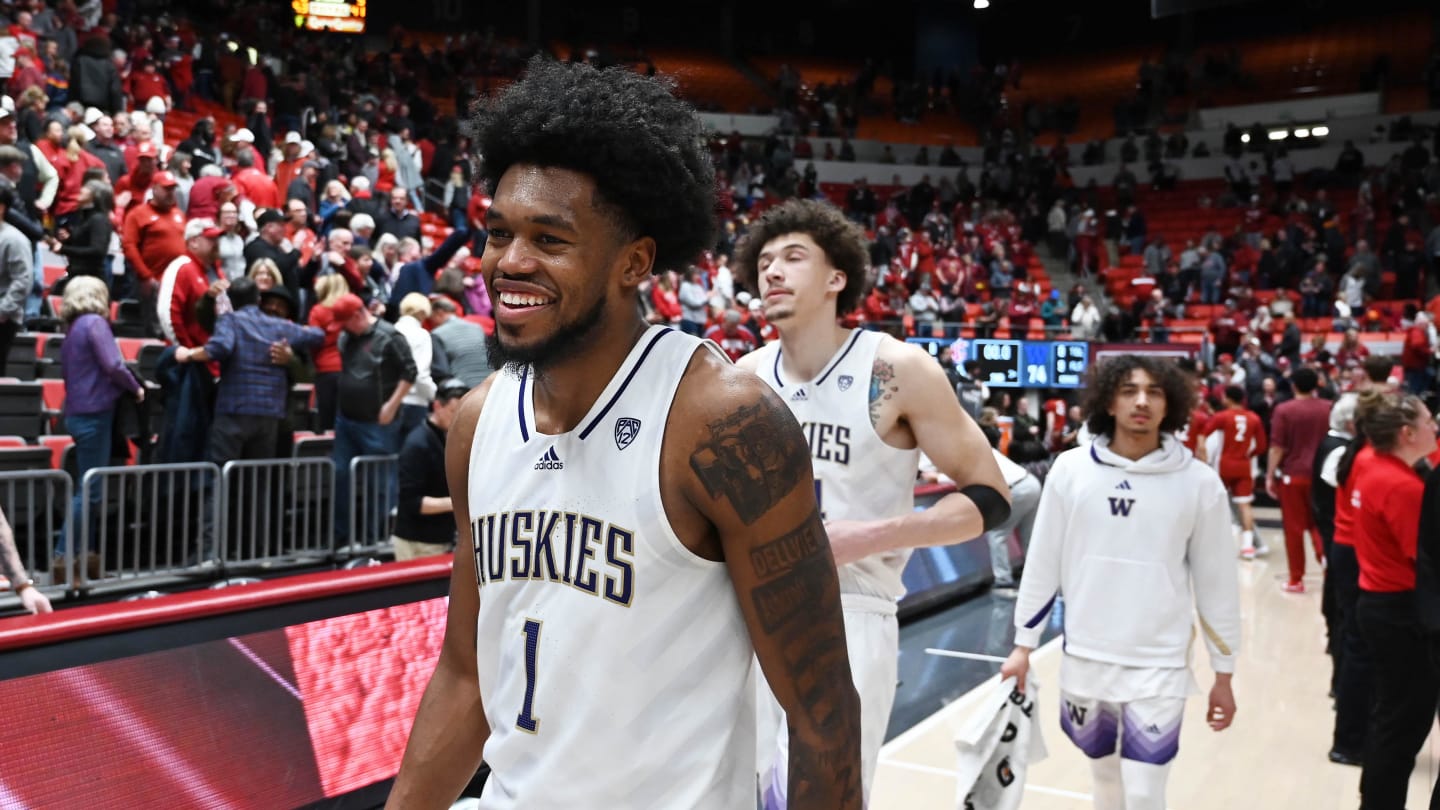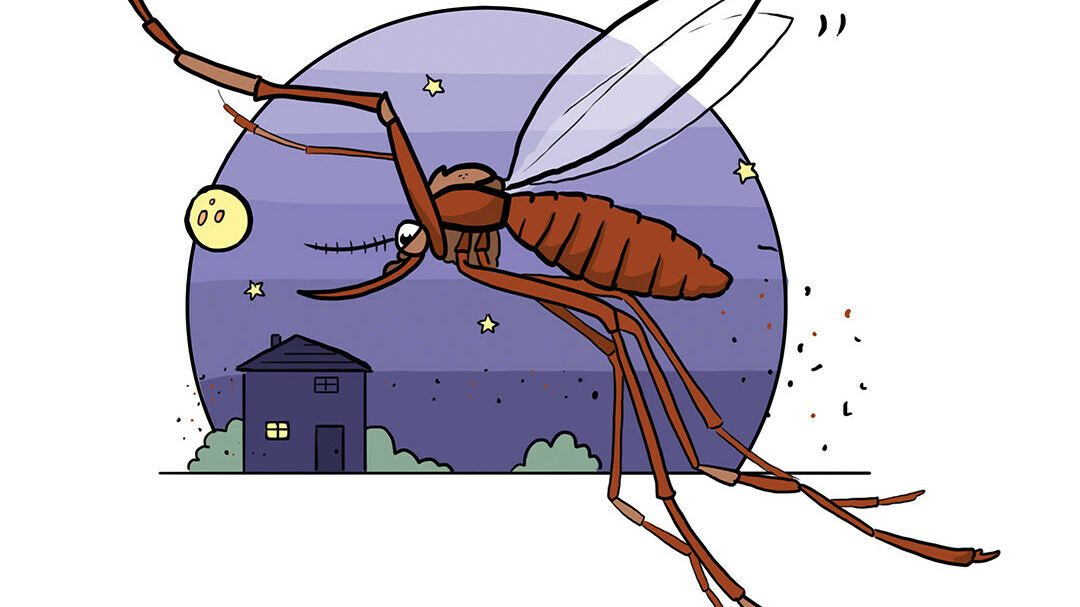South Dakota
Trump up by almost 20 points over Biden in South Dakota

Former President Donald Trump
SIOUX FALLS, S.D. (SOUTH DAKOTA NEWS WATCH) – Former President Donald Trump leads President Joe Biden by nearly 20 points in South Dakota but is struggling to get more than half of the statewide vote, according to a scientific poll of 500 registered voters co-sponsored by South Dakota News Watch.
Trump was at 50%, well ahead of Biden’s 31% in the poll, which was also sponsored by the Chiesman Center for Democracy at the University of South Dakota.
Third-party challenger Robert Kennedy Jr., who is not yet on the ballot in the state, polled at 11% percent, while 7% were undecided.
Those holdouts are keeping former President Trump from matching his previous election share of 62% in South Dakota the last two presidential cycles – against Hillary Clinton in 2016 and Biden in 2020. Trump won the presidency in 2016 and lost in 2020.
A similar Mason-Dixon poll in October 2020 showed Trump at 51% in South Dakota (with 6% undecided), but the former Manhattan real estate mogul and reality TV star came in 11 points higher than that number on Election Day.
There could also be major movement this time around, said Jon Schaff, a political science professor at Northern State University in Aberdeen.
“The support you’re seeing for (RFK Jr.) is not uncommon for a quasi-significant third-party candidate at this stage of the game,” said Schaff. “When you get closer to the election and people realize that candidate doesn’t have a chance of winning, voters tend to drift back to a major-party candidate. And so I suspect that 11% (for Kennedy) will go down.”
The only third-party candidate to reach double-digits in South Dakota in the past century was Texas billionaire Ross Perot, who finished third in 1992 with 22% behind Republican George H.W. Bush (41%) and Democrat Bill Clinton (37%). Clinton won nationally against the incumbent Bush.

South Dakota
Decoying Prairie Bucks with Dad

We awoke to a howling wind beating against our uninsulated 14-foot enclosed trailer. As I sat up, my breath hung in the air like a fog. I fumbled around for a lighter to spark the propane buddy heater and noticed that the internal thermometer was resting at 24ºF.
“Welcome to South Dakota,” I said to my dad, who was about to embark on the first Western hunt of his life.
We knew it was going to be cold, but our weather app didn’t predicted the arctic storm that had turned a welcoming autumn prairie into a frozen landscape.
As I stepped out to brush my teeth, I was met by subzero temperatures and a 30-mph sustained wind that stung my face. There was a 1-inch coating of ice on everything from the barbed wire fence we had parked alongside to the sage brush meadow we would be hunting.
We fired up the Coleman propane burner and I cracked a few eggs into the pan. As the eggs were just about to finish up, the flame on the burner went out. Not thinking much of it, I swapped propane canisters and tried to restart the stove, but to no avail. Heck, the lighter wasn’t even sparking. I held the lighter up to my face and clicked it again, producing a flame almost immediately. As I slowly moved it toward the burner, it was magically snuffed out again. That’s when I realized we were running out of oxygen, and fast. In our haste to heat things up in the trailer, we had forgotten to open the vents and nearly ended the trip early with carbon monoxide poisoning.
At this moment I knew that we’d be making lots of memories on this trip — if we survived it.
Learning the Hard Way
Photo by Derek Horner
During the three previous deer seasons, I had spent a week in November hunting my way across the prairie with my bow. Coming from the big woods of Pennsylvania, the South Dakota landscape might have felt like the moon: flat and lifeless.
But there were more deer than I ever thought possible. Glassing from a little high point could lead to seeing 30 to 40 deer at a time, with some giant muleys in the mix. But the nearly featureless terrain made closing that distance a real challenge. With a rifle, those week-long excursions would have ended by day two or three; with a bow, I spent day after day belly crawling hundreds of yards just to get busted as I sat up to draw.
It took three seasons for me to kill my first prairie buck — a nice whitetail — and I did so out of pure luck. But the success gave me the confidence to finally invite along the man who taught me to deer hunt. I hoped I could now help my dad find success in this wide open country.
Into the Frozen Fog
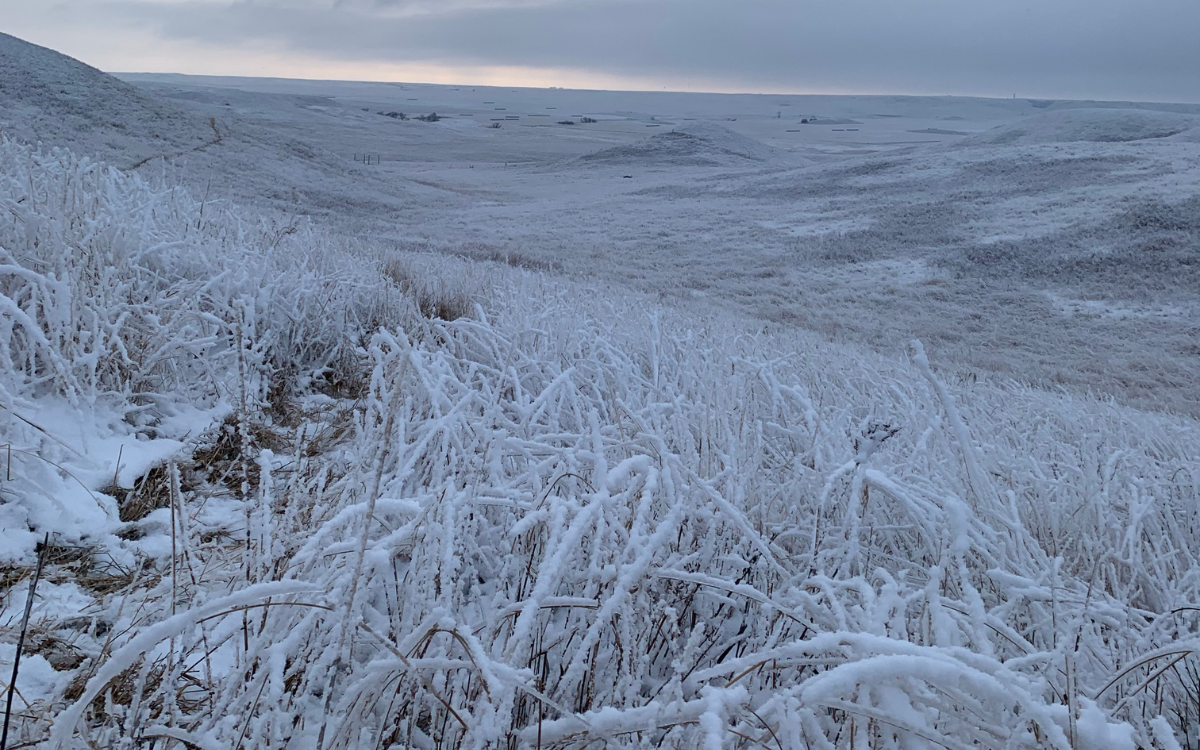
Photo by Derek Horner
After we opened the vents of the trailer and made sure we had enough oxygen flowing, we finished breakfast and put on the rest of our layers. Emerging from the trailer looking like camouflaged Michelin men, we took our first few steps into the prairie. Almost immediately, I knew we were in trouble.
Each step we took produced a thunderous crash of ice. It sounded like we were smashing glass Coke bottles with every move.
“How on Earth are we ever going to close the gap on a mule deer when they can hear us coming from a mile away?” my dad asked.
“I guess we’re going to find out,” I replied.
As I pondered our predicament, another obstacle presented itself. Just as daylight broke, a dense fog started to set in. It was one of the weirdest fogs I’d ever experienced. The wind hadn’t let up and the real feel was somewhere near -30ºF, but we couldn’t see more than 10 feet in front of us. The small creek bottom we planned to glass was only 200 yards away, but it was totally obscured. We decided that our best play was to sit and wait it out.
After about 20 minutes, we were both shaking from the brutal cold so we took turns walking along the backside of the glassing knob to warm up. When the fog finally lifted enough to see the creek bottom, we were sorely disappointed to see three other hunters creeping along both sides of the creek.
We packed up and headed to the next waypoint on the map.
Winter Wonderland
I knew that there were deer in our new area from prior trips, but I was stunned by how many appeared at our first glassing knob. Every draw seemed to have a herd of mule deer. I’m not sure why, but it was as if every deer in the state was packed into this mile-long corridor of hills.
We set up the spotting scope quickly, and within a minute or two, I was directing my dad’s attention to a long and narrow draw about 800 yards to our right. Bedded within the draw was a giant 6×5 buck with a harem of does. When my dad saw the buck his eyes lit up and we quickly began crafting a plan for his first stalk.
Due to the lack of cover, he would have to back off of our glassing knob and make a ¾-mile loop around the hills to remain out of sight. We planned his final approach as well, picking out a rock as a landmark to guide him in. I’d stay back with the spotter to watch.
After what felt like an eternity of sitting there waiting for him to pop back up near the draw, I finally caught a glimpse of movement as he made the final approach. Somehow, even with the glass-crushing icy conditions, he was able to get within 100 yards of the bedded buck. Then 90 yards, 80 yards… 70 yards. Crawling on his hands and knees it seemed as though my 52-year-old dad was going to get a crack at this deer. Then, heartbreak. One of the does in the group had heard enough and busted out, taking the whole herd with her.
It was a scene I had experienced countless times in the years prior, but it felt different watching the disappointment in my dad as he hiked back to our glassing knob.
“I really thought I had a chance there, what’d I do wrong?” he asked.
The answer was that he’d done everything right, and the only thing to do was try again.
Decoy Tactics
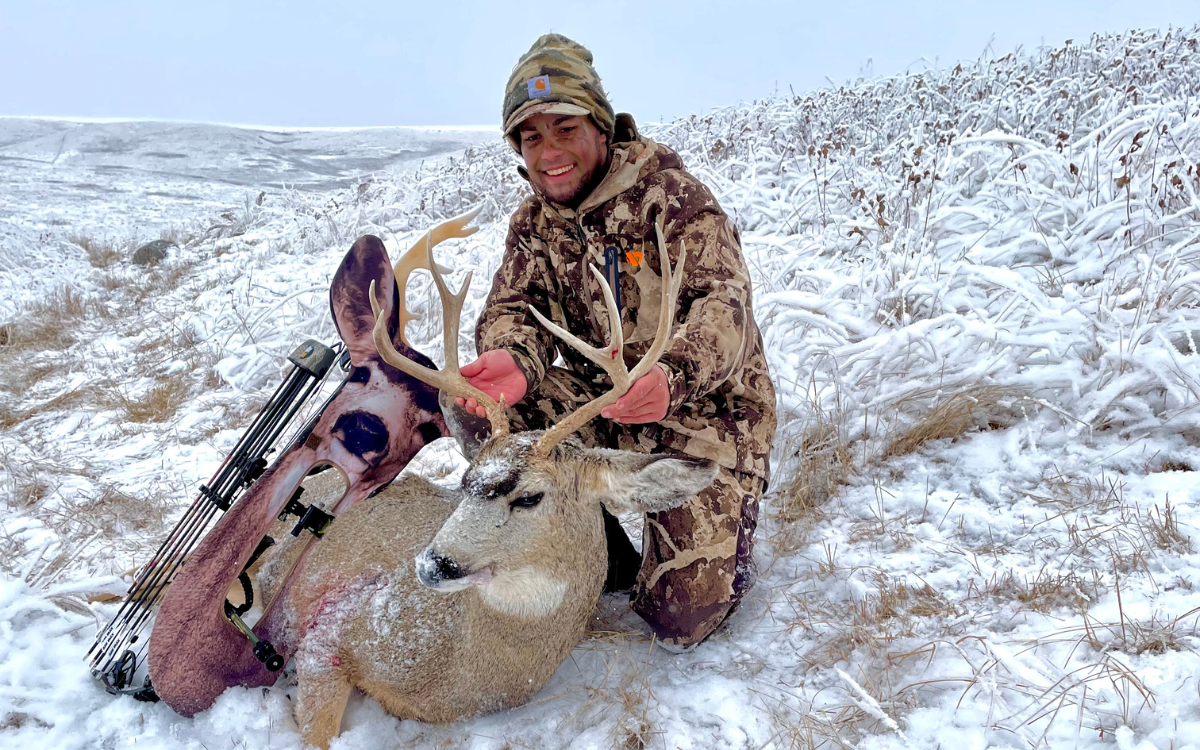
Photo by Derek Horner
From there, we went on a streak of bad luck. For days, stalk after stalk, we’d just keep getting busted on the edge of bow range. The crunchy ice made closing the final 10- to 20-yards a seemingly impossible task. It was time to go back to the drawing board.
There were plenty of deer, and lots of quality bucks worth chasing. So, I decided to throw caution to the wind and try a new tactic: a bow mounted decoy system that my girlfriend had gifted me. I thought it just might be crazy enough to work.
Read Next: Best Deer Decoys
On the fourth day of our trip, as we sat on a glassing knob enjoying our coffee in the -20ºF real feel, I spotted a small 2×3 chasing a doe at the bottom of a series of draws. It seemed like the perfect opportunity to test out the bow decoy. After a short approach, I came into view 80 yards away, the small buck snorted at me and began raking the sagebrush and stomping. He then trotted toward me and stopped at 25 yards. I was in awe. Not only was the buck in bow range, but it genuinely believed I was another deer.
“This thing is totally going to work,” I told my dad.
That afternoon, we approached a new glassing knob and spotted a nice 4×4 locked down with a doe about a half-mile away.
I stalked into a basin about 350-yards away from the bedded couple. As I began to slowly scoot forward with the decoy up, a decent 3×3 crested the hill and walked right into their draw.
The two bucks did a few circles around each other before locking up and having a 30-second knock-down, drag-out brawl. The 4×4 was able to flip the 3×3 on his side, ending the battle. Once the 3×3 vanished out of sight, the 4×4 took a few seconds to shake off and recover, then he locked onto my decoy.
Suddenly, he was sprinting at me — 150 yards away, 100 yards, 50 yards, and then he disappeared behind a dip in the terrain. But I could still hear him crashing through the sage. He popped out at 25 yards and stopped. He pinned his ears back and let out a deep, guttural groan. Then, he started slowly circling me, raking the ground with his hoof.
At 15 yards, he stopped and lowered his head to rake the sage with his antlers. I took the chance to draw and settled my pin on the crease of his shoulder. As he took one more step, he opened his vitals and I released.
Photo by Derek Horner
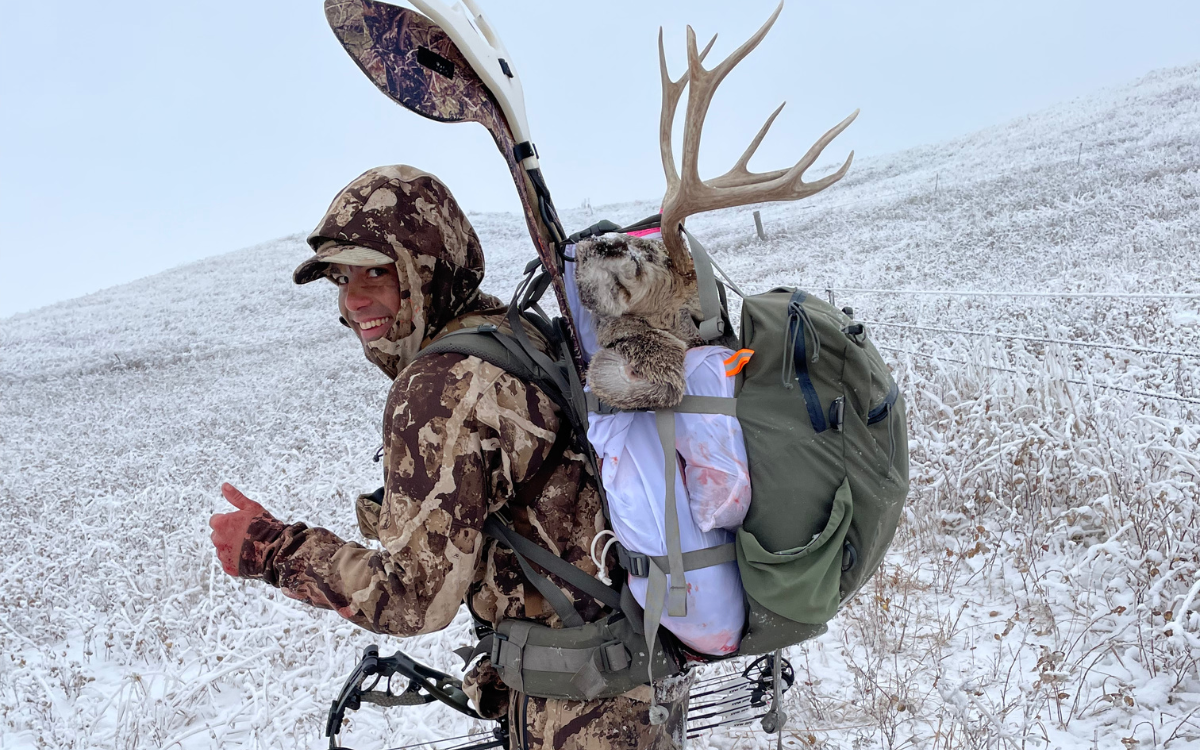
The arrow hit its mark and passed through, but somehow the buck didn’t seem to notice. He took two more steps toward me before expiring. Once he hit the ground, time stood still. My four-year journey to tag a mule deer with my bow was complete, and it was that much sweeter to have my dad with me to experience it.
Read Next: Mule Deer Hunting Tips
We quartered the buck and packed him out just before darkness settled. That night we celebrated in town with burgers and beers. The heater next to our table helped thaw us out as we relived the hunt, over and over.
A Final Stalk on the Final Day
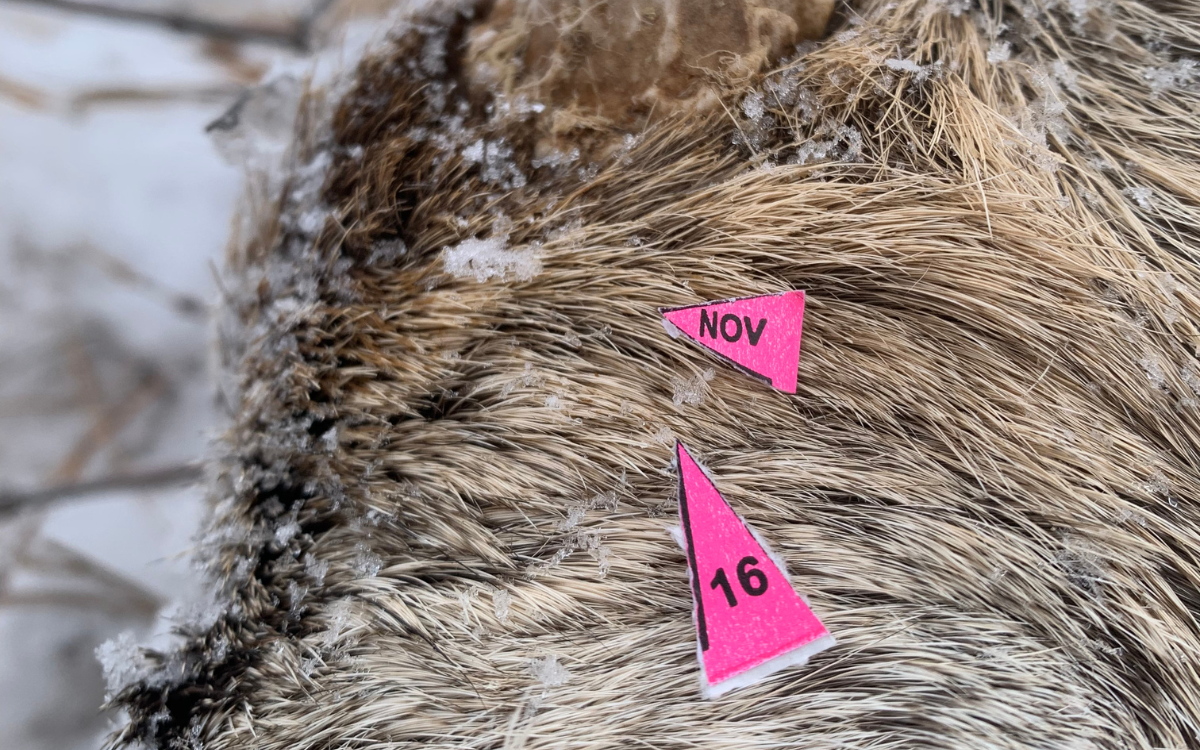
Photo by Derek Horner
Over the next few days my dad had more long stalks and close calls but never got into range of a shooter buck. As the sun crested the horizon on our final day, the meadow around our glassing knob glistened like a chandelier. Things just felt right.
We spent the majority of the morning, into the afternoon, glassing for a single buck locked down with one doe. We had decided that the bucks holding down a harem of does had too many eyes guarding them. If we were going to spend the time stalking, it needed to be the right situation.
As the late afternoon approached, we had seen plenty of nice bucks off in the distance, but each one had six or seven does by their side. It was beginning to feel like the magic of the final day was running out. In a last-minute decision with about an hour and a half of daylight left, we decided to drive 20 minutes south to another walk-in spot where we had glassed bucks previously. As we approached our parking spot, we looked across the prairie. As if God himself had placed him there for us, there stood a buck: a big 3×3 tending a single doe.
They were about 600 yards away, and there wasn’t any way to make a stealthy approach. They were on a slight rise in the middle of a giant flat, so we sat and pondered for a few minutes.
“There’s no way they let me walk out across the open to them without spooking at some point, right?” Dad asked me.
“I don’t see any other options,” I said, trying to sound as encouraging as possible.
Deep down, I had the same feeling he did. There was a lot of open ground to cover, and even with the decoy, they’d be watching him the entire way.
“Well, no time like the present,” he said, chuckling as he strapped on the decoy and stood up to begin his stalk.
I stayed put, watching from our elevated position as he made his way down the hill and onto the flat. The deer locked in on him and were staring hard as he slowly crept along. At 400-yards, he stopped to relax his arm for a few seconds. The buck and doe were still intently watching, but not showing signs of concern.
He continued forward, 300 yards, 200 yards, 100 yards… the deer still watching every step. Once he broke the 70-yard mark, my heart began to pound.
Holy shit, he’s actually got a chance here.
The wind was howling, so my dad continued pushing, trying to get as close as they would allow. At 60 yards, he slowly and carefully nocked an arrow. The deer were still keeping an eye on him, and I could see the doe was becoming agitated. He gained five more yards before she stood up.
In an instant, the buck stood too, and I watched my dad draw. My position was perfect for having both the buck and my dad in the spotting scope at the same time. Suddenly, the buck mule-kicked and took off to the west; his doe was left standing there wondering what had happened. I’d never seen the arrow and neither had she.
Photo by Derek Horner
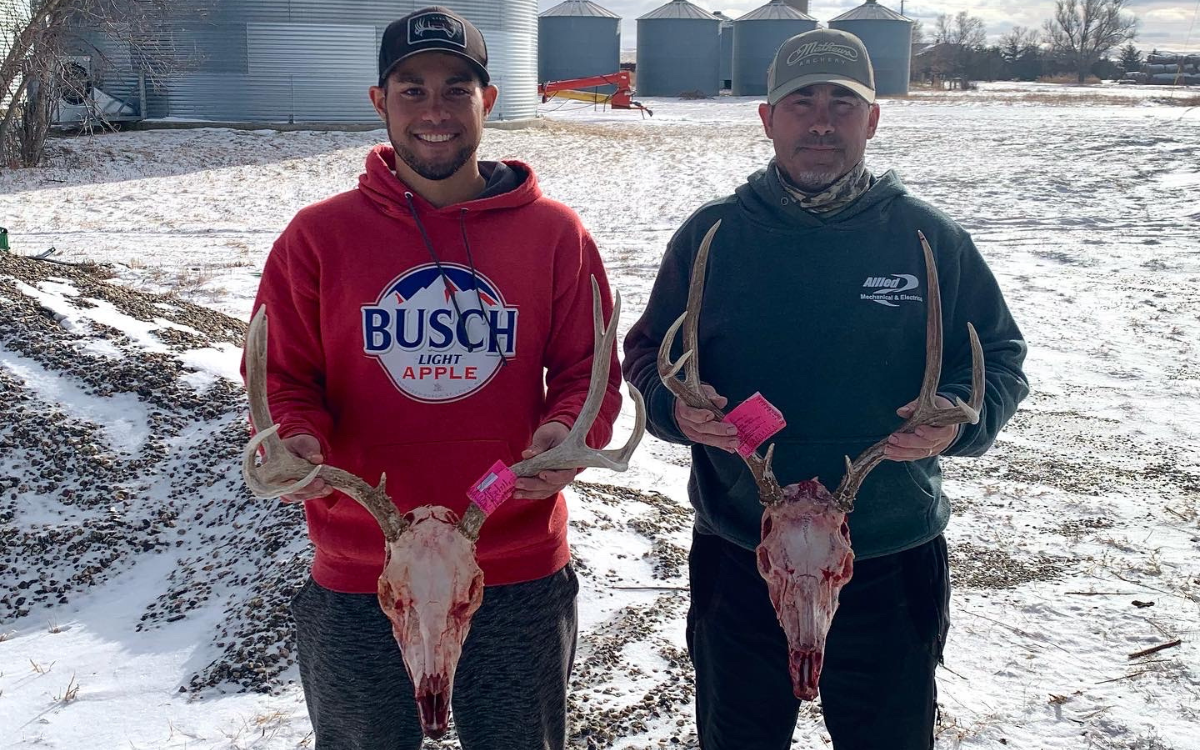
I tracked the buck with the spotting scope and could see a trail of blood in the snowy prairie grass behind him. After about 150 yards, he bedded down. Not long after, I watched through the spotter as he expired. I had been giving my dad hand signals to just wait where he was, but once the buck put its head down for a final time, I fist pumped and took off running down the hill and tackle-hugged him into the snow.
It was the toughest week of hunting either of us had ever had. And that final hour, of the final day, was one of the sweetest moments we’ve ever shared. Most days I find myself daydreaming about the end of that frozen hunt, but especially on Father’s Day.
South Dakota
SDSU team creates plan for biodegradable grocery bags

BROOKINGS, S.D. (KELO) – A group of SDSU students are back from Kenya this week after competing for a Hult Prize — which is a global program challenging college students to solve the world’s most pressing issues.
Extraordinary things can happen inside a scientific lab. For example, a plastic film made out of soybean hulls and sustainable chemicals. The hope is that one day, it could create entire grocery bags.
“Our product, bAGgy, instead of going into landfill or ocean for 500 years in order to decompose, it takes 60 days for the plastic films to decompose,” Hunter Eide, an SDSU graduate who helped create Agri-Cycle Innovations, said.
It’s a business plan created by four students at SDSU, combined with the research of Dr. Srinivas Janaswamy and his graduate students.
“It’s going to function very similar to your regular plastic bag that for like the consumers at the end, the experience will be the same for them,” Kylie Rosenau, an SDSU student who helped create Agri-Cycle Innovations, said. “So really takes the burden of having to recycle or reuse off of them and puts it on like the manufacturers.”
They call it Agri-Cycle Innovations and it led this team to Kenya for the second round of an international contest. They were picked as one of 360 teams out of 10,000 around the world to advance for the Hult Prize.
“I always like believed in our team and what we put together, but it’s like when you know there’s that many people and so many incredible ideas coming into this, it’s not like we were over-confident by any means,” Rosenau said. “So, it was really just kind of confirmed that, yeah, we’ve put something great together.”
Unfortunately, the SDSU team did not win the one million dollar grand prize, but they are proud of what they created.
“Oftentimes, it seems like the world is in a lot of crisis, there’s a lot of bad things, but you know, what can we as young and the next generation do to help positively change,” Eide said. “And continue to do it in a way to generate business and the economy in order to go forward with that.”
The students say soybean hulls were picked because it’s the part of the soybean that isn’t used for food or animal feed. So, it can be used without farmers having to plant more crop in order to make the bags.
South Dakota
Hot topics in agriculture discussed at South Dakota Governor’s Agricultural Summit

HURON, S.D. — The South Dakota Governor’s Agricultural Summit was held June 12 and 13 at the South Dakota State Fairgrounds in Huron, South Dakota. Industry and business leaders from across the state came together to discuss pressing issues within agriculture and shed some light on the state’s No. 1 industry.
“We do (agriculture) better than anybody else in the world and we do it better in South Dakota than anybody else in the country. We have, in South Dakota, more cows per people than any other state. So that’s a good thing to maintain,” South Dakota Governor Kristi Noem told the audience. “We like that about 95% of our South Dakota farms are still family owned and family operated, which is something I’m very proud of. And ag contributes over $32 billion to our economy in our state. About 30% of our economic output comes from the agriculture industry. When ag prospers, all of South Dakota prospers.”
Noem made an appearance to present the 2024 Governor’s Ag Ambassador award to this year’s recipient and longtime WNAX radio newsman, Jerry Oster, from Yankton, South Dakota. Noem also highlighted the importance of the work that goes into agricultural policy and how that affects the state’s farmers and ranchers.
“I’ve been working on policy for over 30 years and for me, it’s been a very different type of discussion than I think some people have when they look at ag policy. From my time first serving on committees and working on commissions in Washington, D.C., in my twenties, it’s been a national security issue,” Noem said. “One of the things I would hope that when we leave here, we remember the bigger goal is that it’s about how we feed the world and that’s important. We also have our policies, our programs, farm bills, in place to keep a safety net out there so that we have a lot of farmers and ranchers that can be successful and keep our No. 1 industry strong and safe.”
Beth Thompson, South Dakota’s state veterinarian and executive secretary of the South Dakota Animal Industry Board, presented an update on the highly pathogenic avian influenza, highlighting the impact on both poultry and dairy farms.
Kennedy Tesch / Agweek
“In South Dakota, it’s been some months since we’ve seen highly pathogenic avian influenza in poultry, which is good because we just made it through the spring migratory season,” Thompson said. “Unfortunately, we are seeing avian influenza in dairy and we’ve had five sites here in the state of South Dakota. The animal industry board is working very closely with those dairy farmers and their veterinarians and hopefully, we’ll be at the end of the cases and move forward into the summer.”
Thompson said in mitigating spreading of the virus, biosecurity becomes king.
“Biosecurity is important because you want to keep whatever disease you may have on your site, on your site and not share it with your neighbors,” she said. “But you also want to keep anything off your site, too. So things like watching your visitors, making sure that nobody’s coming on your site unless you know about it, making sure that you’re watching your animals and working with your veterinarian very closely in case you see anything going on with your herd or flock.”

Kennedy Tesch / Agweek
The impacts of trade on South Dakota’s economy fueled a panel discussion led by Luke Lindberg, president and CEO of South Dakota Trade, with Jerry Schmitz, executive director of South Dakota Soybean, Dennis Harstad, general manager of Houdek, and Cesar Garcia Arevalo, export sales and marketing manager for Advanced Sunflower, participating.

Kennedy Tesch / Agweek
“South Dakota is a prolific exporter of agricultural products. It’s $5 billion a year, roughly speaking, and our state only exports about $7 billion of goods and services. So agriculture is definitely our No. 1 export product. When we look at it in comparison to states all across the country, we’re actually the second highest per capita ag exporter,” Lindberg said. “A lot of those markets are overseas, 96% of the world’s population lives outside the United States, 4% live in the United States. So those are the markets we’re trying to position them for and find ways to sell their products.”
While businesses and organizations work to secure new markets for agricultural products, Elaine Kub, a market economist based in South Dakota, said that going into 2024 and 2025, the outlook is “looking a little less sunny this year than it has in some of the previous years.”
While Kub pointed out that the frustrating part about markets is that producers really have no control over the prices, she mentioned some steps they can take to get through this period of low markets.

Kennedy Tesch / Agweek
“They have to make decisions for their own costs of production, and we can try and bring that down. Land prices are a big piece of that and interest rates, how much interest you’re paying for land or any other input is a big piece of that. Of course, we don’t have any control over interest rates, but we have control over spending patterns or borrowing patterns, she said. “Operational decisions like that can make a difference and also marketing — you can be kind of smart about marketing grain ahead of time and seasons of the year that tend to typically have higher seasonal prices than those harvest time prices.”
Despite the low commodity prices, Hunter Roberts, Secretary of the Department of Agriculture and Natural Resources, remains optimistic.

Kennedy Tesch / Agweek
“We have plenty of challenges like every state, every industry, but agriculture itself is in a great spot,” Roberts said. “We need to continue to move forward. Commodity price wise, we’re down a little bit but moisture wise, we’re looking pretty good. We have a good crop in the ground, so I’m very optimistic about the future of agriculture. I think things are looking up.”
The Governor’s Ag Summit continued on June 13 for day two with presentations on the history of the South Dakota State Fair, touring a nearby Spink Hutterite colony and Kasemeister Creamery and a concert in the DEX building on the fairgrounds featuring country music artist, Thomas Rhett.
-

 News1 week ago
News1 week agoIsrael used a U.S.-made bomb in a deadly U.N. school strike in Gaza
-

 World1 week ago
World1 week agoFrance to provide Ukraine with its Mirage combat aircraft
-

 World1 week ago
World1 week agoWorld leaders, veterans mark D-Day’s 80th anniversary in France
-

 World1 week ago
World1 week agoRussia-Ukraine war: List of key events, day 833
-

 News1 week ago
News1 week agoNonprofit CFO Accused of 'Simply Astonishing' Fraud
-

 Movie Reviews1 week ago
Movie Reviews1 week agoInsane Like Me? – Review | Vampire Horror Movie | Heaven of Horror
-

 Politics1 week ago
Politics1 week agoGeorge Clooney called White House to complain about Biden’s criticism of ICC and defend wife’s work: report
-

 Politics1 week ago
Politics1 week agoNewson, Dem leaders try to negotiate Prop 47 reform off California ballots, as GOP wants to let voters decide

